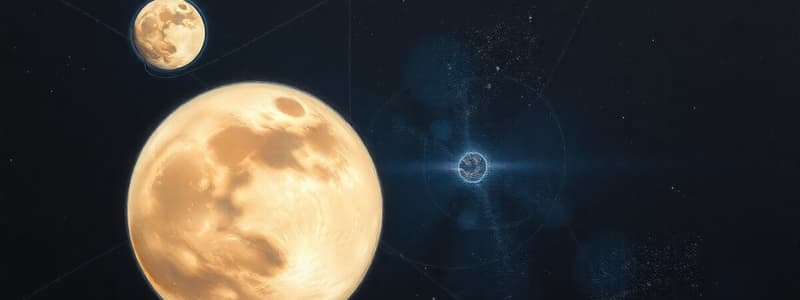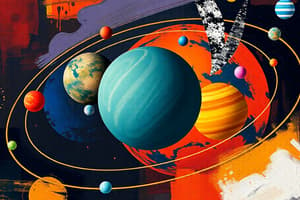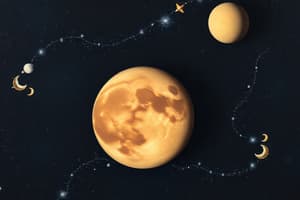Podcast
Questions and Answers
What is the key distinction between a dwarf planet and a regular planet of similar size?
What is the key distinction between a dwarf planet and a regular planet of similar size?
- Dwarf planets are closer to the Sun.
- Dwarf planets lack the gravitational force to clear their orbits of other objects. (correct)
- Dwarf planets are entirely composed of ice.
- Dwarf planets do not orbit the Sun.
Which of the following is a characteristic shared by both dwarf planets and regular planets?
Which of the following is a characteristic shared by both dwarf planets and regular planets?
- Being located exclusively in the Kuiper Belt
- Having a clear orbital path around the Sun
- Being nearly round in shape due to their mass and gravity (correct)
- Having a measurable atmosphere
Ceres is unique among the recognized dwarf planets because it is:
Ceres is unique among the recognized dwarf planets because it is:
- Located in the Kuiper Belt.
- The only dwarf planet with a known atmosphere.
- The only dwarf planet explored by the New Horizons spacecraft.
- The largest object in the asteroid belt and located in the inner solar system. (correct)
Why is Pluto sometimes referred to as the 'King of the Kuiper Belt'?
Why is Pluto sometimes referred to as the 'King of the Kuiper Belt'?
What is a distinctive feature of Haumea that sets it apart from other dwarf planets?
What is a distinctive feature of Haumea that sets it apart from other dwarf planets?
The discovery of which dwarf planet significantly influenced the International Astronomical Union's decision to reclassify planets?
The discovery of which dwarf planet significantly influenced the International Astronomical Union's decision to reclassify planets?
Which spacecraft was the first to explore Pluto up close?
Which spacecraft was the first to explore Pluto up close?
What is the approximate length of a 'year' on Eris, in Earth years?
What is the approximate length of a 'year' on Eris, in Earth years?
Haumea is named after a goddess from which culture?
Haumea is named after a goddess from which culture?
Which of Pluto's moons is the largest?
Which of Pluto's moons is the largest?
Makemake's discovery contributed to the reclassification of planets, what was its unofficial codename?
Makemake's discovery contributed to the reclassification of planets, what was its unofficial codename?
Eris has a moon named Dysnomia, after the daughter of Eris who is the goddess of what?
Eris has a moon named Dysnomia, after the daughter of Eris who is the goddess of what?
If you weigh 100 pounds on Earth, how much would you weigh on Pluto?
If you weigh 100 pounds on Earth, how much would you weigh on Pluto?
Which dwarf planet was the first to be explored by a spacecraft?
Which dwarf planet was the first to be explored by a spacecraft?
Haumea has two known moons, Hi'iaka is the outer moon, what is the name of the inner moon?
Haumea has two known moons, Hi'iaka is the outer moon, what is the name of the inner moon?
Eris completes one rotation every 25.9 hours, compared to Earth. How is its day length described?
Eris completes one rotation every 25.9 hours, compared to Earth. How is its day length described?
Which roman god is pluto named after?
Which roman god is pluto named after?
Which dwarf planet is nicknamed Santa and the first known Kuiper Belt Object to have rings?
Which dwarf planet is nicknamed Santa and the first known Kuiper Belt Object to have rings?
The word 'cereal' comes from the same name as which dwarf planet?
The word 'cereal' comes from the same name as which dwarf planet?
Where are Makemake, Pluto, Eris, and Haumea located?
Where are Makemake, Pluto, Eris, and Haumea located?
Flashcards
What are dwarf planets?
What are dwarf planets?
Objects orbiting the Sun, nearly round, but unable to clear their orbit of debris.
What is Ceres?
What is Ceres?
Largest object in the asteroid belt, located in the inner solar system.
What is Pluto?
What is Pluto?
A complex world in the Kuiper Belt with mountains, valleys, and a thin atmosphere.
What is Haumea?
What is Haumea?
Signup and view all the flashcards
What is Makemake?
What is Makemake?
Signup and view all the flashcards
What is Eris?
What is Eris?
Signup and view all the flashcards
What is the Kuiper Belt?
What is the Kuiper Belt?
Signup and view all the flashcards
What are Plutoids?
What are Plutoids?
Signup and view all the flashcards
Study Notes
Dwarf Planets: An Overview
- Are celestial objects orbiting the Sun
- Are nearly round
- Have not cleared their orbit of debris
- The International Astronomical Union (IAU) recognizes only five: Ceres, Pluto, Haumea, Makemake, and Eris
- There could be over a hundred more waiting to be discovered
- They aren't able to pull in and accumulate material in their orbits due to their smaller size
Similarities to Regular Planets
- Both have enough mass and gravity to be nearly round
- Both travel through space in a path around the Sun
Key Difference From Regular Planets
- Dwarf planets paths are full of other objects like asteroids,
- Regular planets have clear paths around the sun because most impacts occurred billions of years ago
Ceres
- Largest object in the asteroid belt between Mars and Jupiter
- The only dwarf planet located in the inner solar system
- Named after the Roman goddess of corn and harvests
- The word cereal comes from this name
- Has no evidence of an atmosphere
- NASA's Dawn arrived in 2015
- Dawn became the first spacecraft to explore it
Pluto
- A complex, mysterious world with mountains, valleys, plains, craters, and a heart-shaped glacier
- Named after the Roman god of the underworld
- Has a thin atmosphere of nitrogen, methane, and carbon monoxide
- Weighing 100 pounds on Earth is equivalent to weighing 7 pounds on Pluto
- Resides in the Kuiper Belt with icy bodies and dwarf planets
- Known as the "King of the Kuiper Belt" due to being the largest known object in the region
- NASA's New Horizons was the first spacecraft to explore it up close in 2015
- Charon is the largest of Pluto's five moons
Haumea
- One of the fastest-rotating large objects in the solar system, distorting its shape to resemble a football
- Observations are made with ground-based telescopes
- Named after the Hawaiian goddess of fertility
- First known Kuiper Belt Object with rings
- Ring discovery announced in 2017
- Two known moons: Namaka (inner) and Hi'iaka (outer)
- Nicknamed Santa
Makemake
- Located in the Kuiper Belt with Pluto, Eris, and Haumea
- Slightly smaller than Pluto
- Second-brightest object in the Kuiper Belt as seen from Earth
- Takes about 305 Earth years to orbit the Sun
- Discovery prompted the International Astronomical Union to reconsider the definition of a planet
- Unofficial codename: Easterbunny, because it was discovered just after Easter
Eris
- One of the largest known dwarf planets, about the same size as Pluto but three times farther from the Sun
- Takes 557 Earth years to orbit the Sun
- Orbit plane extends far beyond the Kuiper Belt
- Rotates every 25.9 hours, similar to Earth's day length
- Has a very small moon called Dysnomia, which orbits in about 16 days
- Dysnomia is named after the demon goddess of lawlessness
- Likely has a rocky surface similar to Pluto, with surface temperatures varying from -217°C to -243°C
Studying That Suits You
Use AI to generate personalized quizzes and flashcards to suit your learning preferences.




